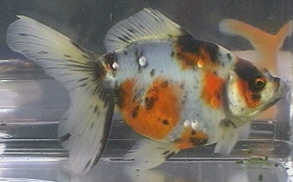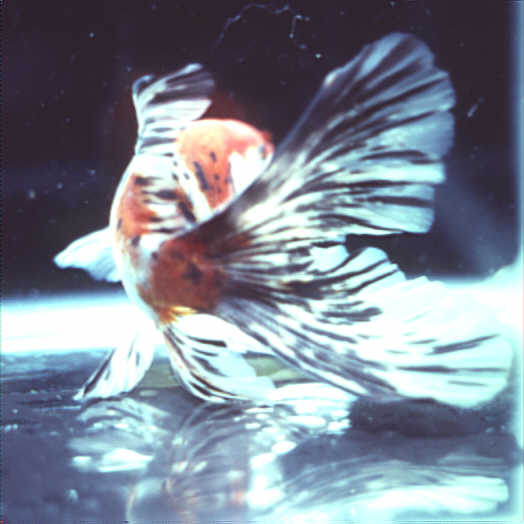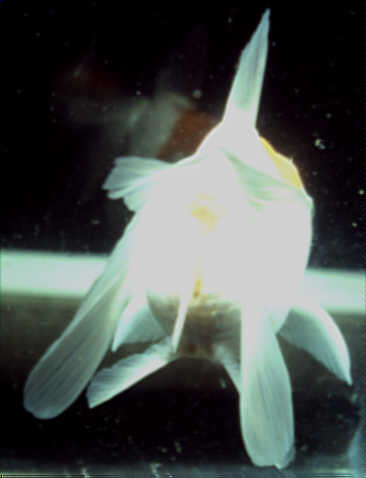


The adipose fin, for example, common to many Characins and Catfish is missing in the majority of other genera and, in some marine species, the pelvic fins are also missing.
Just to be perverse, too, the vent is known to change position between juvenile and adult stages in one fish!
Apart from some cultivated species of Goldfish, most fish have one main dorsal fin; some have hard- and soft-rayed portions of the same fin, whilst many Gobies can be identified by having two separate dorsal fins.
The pelvic fins may be modified into long bony structures as in the freshwater Angelfish, or be filamentous and equipped with taste buds, as in Gouramies.
Observation of the shape and size of the various fins in egglaying species - concave or convex, having thread-like extensions or not, is often a reasonable guide to the sex of its owner. Generally, male fish have the more elongated or ornate fins.
Sexing livebearing fish is a little easier: males of cultivated species, such as Platies, Swordtails and Mollies, have a rod-like anal fin called the gonopodium. Females have the normal, fan-shaped anal fin. Males of other, wild livebearing species may only have a partly-modofied anal fin, showing just a notch towards the front.
Barbels are fleshy 'whiskers' found around the mouths of many fishes, such as Catfishes and Barbs. They are equipped with taste buds and enable fish to locate food in darkness or murky waters.
The lateral line may vary is shape from species to species, may also be incomplete or perhaps encircle the head as well as occupying its usual position along the fish's flanks.
All of the sizes given in the aquatic literature (and the pages on this website) refer to the Standard Length - snout to the end of the caudal peduncle - rather than to the Total Length.
GOLDFISH SCALE GROUPS
 Although there are at least five diaphanic scale groups, the three listed below are used for exhibition purposes. These groups are determined by the amount of crystalline reflective material, Guanine, immediately below the scales and within the upper dermis.There are complex genetic factors surrounding its inheritance but these are not of concern here.
Although there are at least five diaphanic scale groups, the three listed below are used for exhibition purposes. These groups are determined by the amount of crystalline reflective material, Guanine, immediately below the scales and within the upper dermis.There are complex genetic factors surrounding its inheritance but these are not of concern here.

The first of the three exhibition groupings is Metallic, in which all the scales are quite distinguishable, have a layer of guanine backing tile scales giving the appearance of burnished metal, some times alluded to as 'hard scales'.

The second is Nacreous, in which all the scales are still visible some with a scattering of guanine backing scales giving the fish a pearly lustre.

Lastly, Matt, in which the scales are difficult to see and the surface of the fish is dull and devoid of shine with no guanine backing any scales; these are sometimes alluded to as 'soft scales'.
As a general guide:
a) A Metallic fish exhibits no Matt scaling and has a full iris to both eyes.
b) A Matt fish exhibits no Metallic scaling and because of the absence of Guanine no iris to both eyes.These are some times alluded to as 'shoe button eyes' .
c) Nacreous fish are an intermediate type and exhibit a mixture of both Metallic and Matt scaling; the best specimens have an absence of Guanine on their gill plates (operculum) known as'soft gill plates' and full irises to both eyes.
SINGLE or TWIN TAILS ? GOLDFISH FINNAGE & BODY TYPES:
 Those varieties of Goldfish possessing the caudal and anal fins single and median are known as Singletails; Singletails are normal-bodied, ie, basically Common Goldfish shape, they have a body depth of less than one-third of the body length.
Those varieties of Goldfish possessing the caudal and anal fins single and median are known as Singletails; Singletails are normal-bodied, ie, basically Common Goldfish shape, they have a body depth of less than one-third of the body length.
 Those varieties in which the caudal and anal fins are divided and paired are known as Twintails, and those without a Dorsal as Dorsal-less. At present all Dorsal-less varieties are also Twintails. The body shape of Twintailed varieties are more egg-shaped – deeper and shorter in the body than Singletails.
Those varieties in which the caudal and anal fins are divided and paired are known as Twintails, and those without a Dorsal as Dorsal-less. At present all Dorsal-less varieties are also Twintails. The body shape of Twintailed varieties are more egg-shaped – deeper and shorter in the body than Singletails.